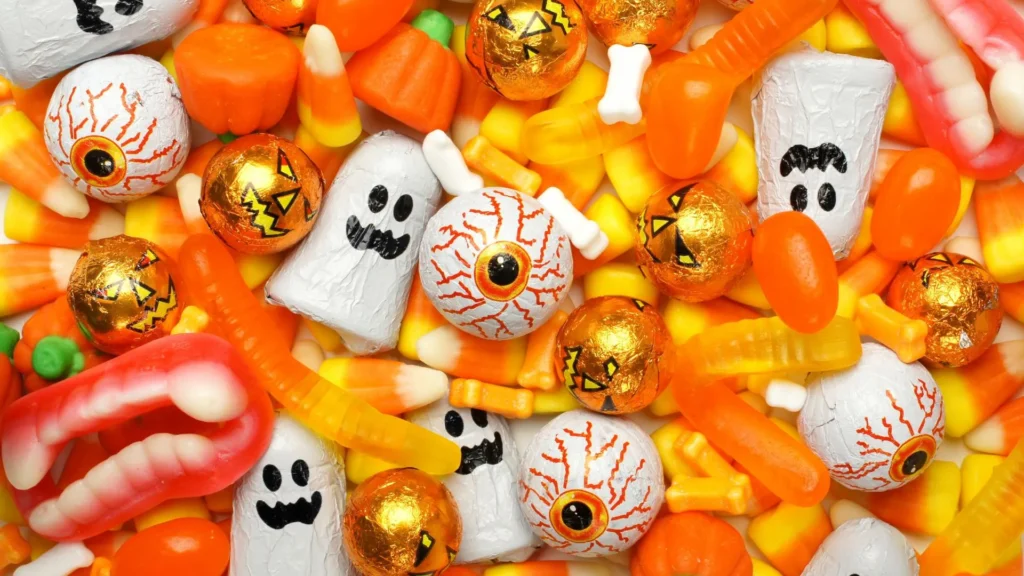
Halloween is a time of spooky fun and plenty of sweets, but it’s also a moment when dental health often takes a backseat. With kids indulging in sugary treats after a night of trick-or-treating, parents are left to navigate the world of Halloween candy, seeking ways to minimize the damage to their children’s teeth. In this guide, we’ll delve into which Halloween treats are less harmful to dental health, explore expert advice, and provide practical tips to help keep those smiles healthy during the festive season.
The Impact of Halloween Candy on Teeth
Consuming sugary treats during Halloween can lead to plaque buildup, cavities, and other oral health problems. When sugar interacts with the bacteria in the mouth, it creates acid that can erode tooth enamel. Sticky and chewy candies tend to adhere to the teeth, prolonging the exposure to this harmful sugar-bacteria reaction. However, some candies are less damaging than others, and it’s essential to understand how different types of treats affect your teeth.
The Worst Halloween Candies for Your Teeth
Not all Halloween candies are created equal. Some treats can be more detrimental to your oral health than others due to their texture, sugar content, and how long they remain in contact with your teeth.
Sticky Candies: The Top Culprits
Candies like Tootsie Rolls and Laffy Taffy are among the worst offenders for oral health. These sticky treats adhere to the teeth, especially in the grooves and crevices, where they can stay trapped for long periods. This prolonged sugar exposure increases the risk of cavities and decay. In addition, the sticky nature makes it difficult for saliva to wash away the sugar, contributing to a longer duration of harm to your teeth.
Hard Candies and Lollipops
While hard candies and lollipops like Jolly Ranchers or Blow Pops may seem harmless, they can still be problematic. Sucking on these treats for an extended period exposes teeth to sugar, which is detrimental over time. Moreover, biting into hard candies can cause cracks or chips in teeth, especially if they are already weakened by cavities or fillings.
Gummy Candies: A Hidden Threat
Gummy candies such as Gummy Bears, Sour Patch Kids, and Licorice may appear innocent, but they are also among the worst for teeth. Their sticky texture means they can linger on your teeth, often even after rinsing your mouth. These candies are packed with sugar and can easily contribute to plaque buildup. Additionally, many gummy candies contain acids that can further erode enamel.
The Best Halloween Candies for Your Teeth
While many candies are harmful to teeth, some are less likely to cause significant damage. Here are some options that are kinder to your child’s dental health.
Chocolate: A Better Option
Chocolate, especially dark chocolate, is generally less harmful to teeth than other sugary treats. It dissolves relatively quickly and doesn’t stay on the teeth long enough to create problems. While chocolate does contain sugar, it’s easier to clean off the teeth with saliva or a simple rinse. Additionally, chocolate contains antioxidants that may even provide some benefits to oral health.
Benefits of Chocolate:
- Dissolves quickly and doesn’t stick to teeth.
- Less likely to contribute to plaque buildup.
- Contains antioxidants, such as flavonoids, which can protect against tooth decay.
Sugar-Free Candies
If you’re concerned about sugar but still want to indulge in Halloween treats, consider sugar-free candies. These treats use artificial sweeteners or sugar alcohols like xylitol, which do not contribute to tooth decay. Xylitol, in particular, has been shown to help reduce the growth of bacteria that cause cavities, making it a beneficial alternative to traditional sugary sweets.
How to Minimize the Damage of Halloween Sweets
Even if you choose the best candies, moderation is key when it comes to Halloween treats. Here are a few strategies to help minimize the damage to your teeth.
Limit Candy Consumption
Instead of spreading candy consumption throughout the day, it’s better to have all the candy at once. This reduces the amount of time your teeth are exposed to sugar. Eating a large amount of candy in a short period also reduces the risk of acid buildup that can harm your enamel.
Drink Water After Eating Candy
After consuming sugary treats, encourage your child to drink water. Water helps rinse the mouth and wash away lingering sugar and acid. This simple action can significantly reduce the likelihood of plaque buildup and cavities.
Wait Before Brushing
It’s important to wait about 20 to 30 minutes after eating candy before brushing teeth. After eating sugary treats, the enamel on your teeth becomes temporarily softened due to the acid produced by bacteria. Brushing immediately can cause enamel wear, so waiting gives your enamel time to re-harden and reduces the risk of damage.
Opt for Healthy Alternatives
For a healthier Halloween snack, consider combining candy with healthier options. For example, candy apples combine the sweetness of sugar with the benefits of fresh fruit and fiber. This reduces the overall sugar load and provides essential nutrients that promote dental health.
Regular Dental Hygiene
Encourage good dental habits during Halloween and beyond. Brushing at least twice a day with fluoride toothpaste and flossing daily can help remove plaque and sugar buildup. Regular visits to the dentist also ensure that any potential issues are detected early.
Conclusion: Enjoy Halloween Without Worrying About Your Teeth
Halloween doesn’t have to mean sacrificing your dental health. By making mindful choices when it comes to candy, practicing good oral hygiene, and seeking out healthier alternatives, you can enjoy the spooky season without compromising your smile. Opt for chocolate over sticky candies, limit sugar intake, and encourage healthy eating habits to keep your teeth safe while indulging in the holiday festivities.
